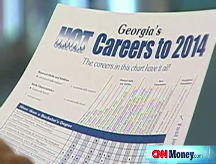Jobs lost in 2008: 1.2 million
Payrolls shrink by 240,000 in October, 10th straight month of cuts. Unemployment soars to 6.5%
NEW YORK (CNNMoney.com) -- The government reported more grim news about the economy Friday, saying employers cut 240,000 jobs in October - bringing the year's total job losses to nearly 1.2 million.
According to the Labor Department's monthly jobs report, the unemployment rate rose to 6.5% from 6.1% in September and higher than economists' forecast of 6.3%. It was the highest unemployment rate since March 1994.
"There is so much bad in this report that it is hard to find any silver lining," said Morgan Keegan analyst Kevin Giddis.
Economists surveyed by Briefing.com had forecast a loss of 200,000 jobs in the month. October's monthly job loss total was less than September's revised loss of 284,000. Payroll cuts in August were revised up to 127,000, which means more than half of this year's job losses have occurred in the last three months.
September had the largest monthly job loss total since November 2001, the last month of the previous recession and just two months after the Sept. 11 terrorist attacks.
With 1,179,000 cuts, the economy has lost more than a million jobs in a year for the first time since 2001 - the last time the economy was in a recession. With most economic indicators signaling even more difficult times ahead, job losses will likely deepen and continue through at least the first half of 2009.
"It's pretty clear that we're in a recession," said Robert Brusca, economist at FAO Economics. "There is reason for us to believe we'll see a drumbeat of heavy job losses for a while, and there's room for them to get even worse."
Brusca noted that separate readings on the manufacturing and auto industries indicated economic conditions are the worst in about 30 years.
"We may be in a severe recession, in which case these job numbers are not even big yet," he said, suggesting monthly job loss totals could grow in excess of 300,000 an unemployment could rise to around 7%.
Job losses were spread across a wide variety of industries. Manufacturing lost 90,000 jobs, the leisure and hospitality industries cut 16,000 jobs, and construction employment shrank further by 49,000 jobs.
Terence O'Sullivan, president of construction workers' Laborers' International Union of North America, noted the construction unemployment rate rose to 10.8% - double what it was a year ago. He called the report an "urgent alarm sounding the need to halt our nation's spiraling job loss."
In an ominous sign for the upcoming holiday shopping season, retailers trimmed payrolls by 38,000 workers last month.
Professional and business services, a category seen by some economists as a proxy for overall economic activity, had a 45,000 drop in employment.
"Job loss has a big impact on the economy," Brusca said. "When people have no income, they spend less, businesses make less money, and they cut more jobs."
In another sign of weakness, a growing number of workers were unable to find jobs with the amount of hours they want to work. Those working part-time jobs - because they couldn't find full-time work, or their hours had been cut back due to slack conditions - jumped by 645,000 people to 6.7 million, the highest since July 1993.
The so-called under-employment rate, which counts those part-time workers, as well as those without jobs who have become discouraged and stopped looking for work, rose to 11.8% from from 11%, matching the all-time high for that measure since calculations for it began in January 1994.
Temporary employment, including workers employed by temp agencies, fell by 50,800 jobs last month. That could mean even more full-time payroll reductions to come, as employers often cut temporary workers before they begin cutting permanent staff.
But some industries were hiring last month. Government hiring has stayed strong throughout the downturn, adding another 23,000 jobs in October. Education and health services also grew payrolls, which grew by 21,000 employees.
In a somewhat encouraging sign, the average hourly work week did not fall last month, holding at 33.6 hours, in line with expectations. With a modest 4-cent gain in the average hourly salary, the average weekly paycheck rose by $1.35 to $611.86.
Solutions are not simple. Support for a second stimulus package has grown in Congress, and President-elect Barack Obama has indicated that he would support such a measure. The prior stimulus package in the spring helped the economy grow in the second quarter, but it did little to stem the tide of job loss in the country. Many economists have also called on the Federal Reserve to cut rates to historic lows to encourage growth.
"These are all the right solutions, but the real question is are they enough to get the economy on the right path," said Anthony Chan, chief economist for JP Morgan private wealth management. "They're necessary, but we don't yet know if they're sufficient."
President Bush said Friday the government's plans to address tight credit and housing markets are the solution to rising unemployment.
"The Federal government has taken aggressive and decisive measures to address this situation," the President said. "It will take time for these measures to have their full impact on an economy in which many Americans are struggling."
Chan said the programs will work, and that the government needs to continue to "slug it out," perhaps putting even more stimulus programs in place to encourage job growth. ![]()



